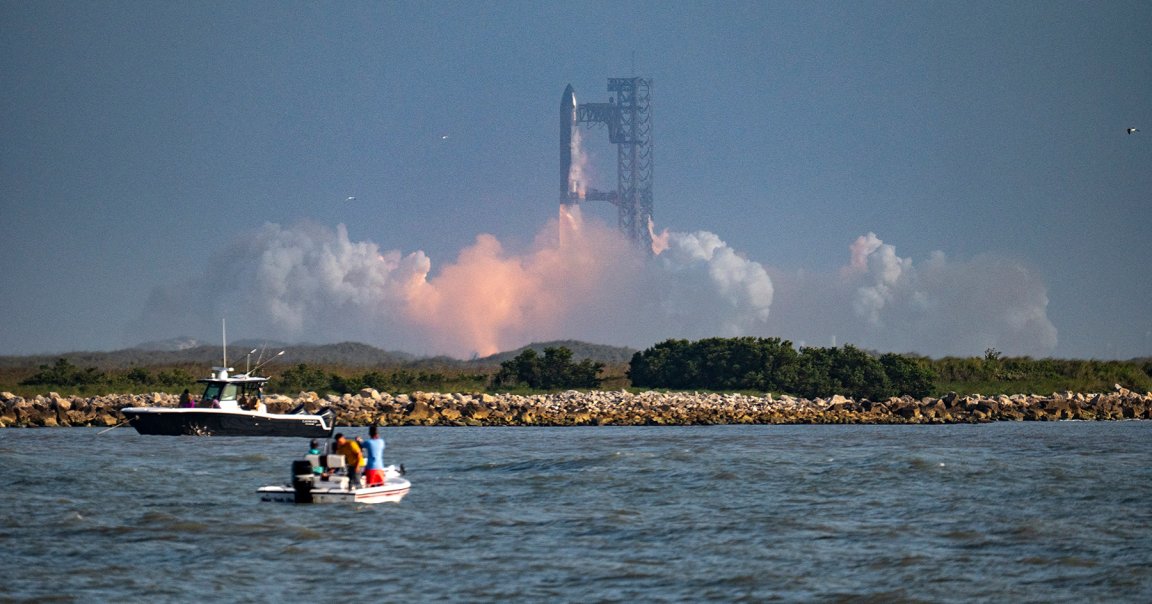
Last week, both stages of SpaceX’s Starship exploded after returning from space. The Super Heavy booster flew apart as it attempted a landing burn over ground, and forty minutes later, the Starship vehicle itself disintegrated somewhere over the Indian Ocean.
It was the Elon Musk-owned space company’s ninth test of its megarocket, the development of which has been plagued by spectacular failures. Failure is part of the company’s formula for success, but the prolonged series of comeupances may be very bad news, according to engineer-turned-journalist Will Lockett.
“Dig a little deeper, and it’s evident that SpaceX has hit an impasse,” Lockett wrote in his newsletter.
Reusability is the Starship’s raison d’être. If the booster and spacecraft can safely perform multiple launches, the idea is that it’ll save SpaceX — and its customers — invaluable time and money that it’d otherwise waste building new ones from scratch. Its other selling point is hauling a massive amount of cargo in one go, facilitating ambitious missions like sending humans to Mars.
Yet two years on since Starship embarked on its maiden test flight, SpaceX is still a long way from achieving reusability or a hefty payload capacity. Regarding the former, last week’s flight test was the first time SpaceX reused a Super Heavy booster, replacing four of its 33 engines. Regarding the latter, the test had Starship carry a dummy payload of a measly 16 metric tons. Musk has previously promised that Starship will carry 150 tons.
In previous tests, the booster guided itself back to its launch tower, where it was caught midair by the structure’s “Chopstick” arms — an unquestionably stunning achievement. For its most recent flight, SpaceX ditched making a catch and aimed for a controlled splash landing in the Pacific. That’s because it was testing sending the booster into a “belly-flop” to increase drag as it re-enters the atmosphere, thereby slowing its descent and reducing the fuel that needs to be burned by its retrorockets, the engines that kick in to assist the landing. Less fuel means less weight, which means more payload capacity, and so forth.
Inauspiciously, the booster exploded right after its retrorockets ignited, suggesting that it was the engines that had failed. The stresses of the belly-flop, it would also appear, proved too much for the craft’s structure.
In Lockett’s analysis, the booster is both too heavy and yet too fragile. If true, then engineers are in a bind: “Super Heavy Booster and its engines need to be heavily reinforced to survive such a landing (especially if it is to be reused, as planned), but doing so would add enough weight to render the entire exercise moot,” Lockett wrote.
The upper stage, meanwhile, made some progress by reaching space and flying at orbital speeds. But in a repeat of the last two tests, it experienced a fuel leak — though instead of instantly exploding, it spiraled out of control and broke up in the atmosphere.
“The fact that it was yet another fuel leak that caused the rocket to fail heavily suggests they have a cascading stress issue,” wrote Lockett. “They strengthened the fuel lines and the structure that supported the rocket engines after flights 7 and 8, but now a component further down the line has failed, suggesting that the stress is being transferred to other, weaker components.”
Lockett’s prognosis is sobering. “The lesson here is that SpaceX somehow needs to make Starship significantly more robust and lighter by well over a hundred tonnes if it is to conduct even one successful mission, let alone achieve constant reuse — which, let’s be clear, is basically impossible,” he added.
Wendy Whitman Cobb, a space policy expert with the School of Advanced Air and Space Studies, summed up SpaceX’s folly. “They are trying to do everything at once with Starship,” Whitman Cobb told the Verge — building a new rocket, making both the booster and spaceship reusable, on top of boasting an unprecedented payload capacity. “It really is a very difficult engineering challenge.”
All the drama with the exploding Starship also stands in contrast to the incremental approach SpaceX took when developing its very reliable Falcon 9 rocket. Attempts to recover a booster weren’t made until years into its development, and even then, it was eventually settled that only the booster — not the entire spacecraft — would be reusable.
Whitman Cobb remains slightly optimistic about the vehicle’s fortunes. “I believe SpaceX will engineer their way out of it,” she added. “I believe their engineering is good enough that they will make Starship work,”
Not Lockett. It’s taken SpaceX “nine failed attempts and almost $10 billion for Starship to not reach orbit with a fraction of its promised payload and to never land an upper stage or successfully reuse a first stage,” he wrote. “All flight 9 has proven is just how much of a dead end Starship is,”
More on SpaceX: If NASA Had Blown Up This Many Rockets, The Government Would Have Cancelled the Space Program